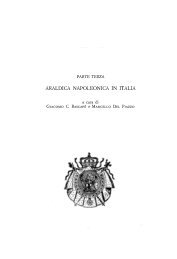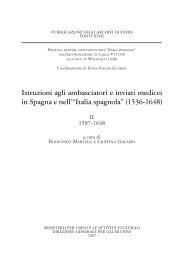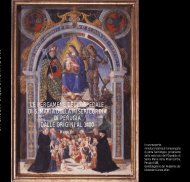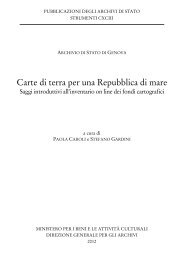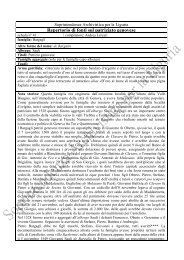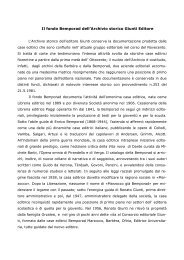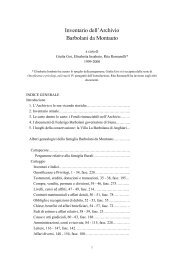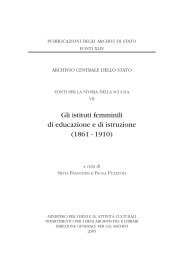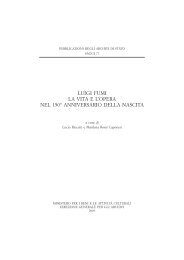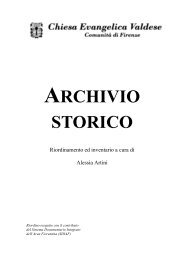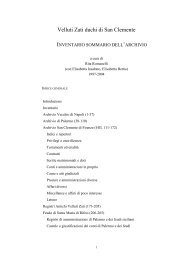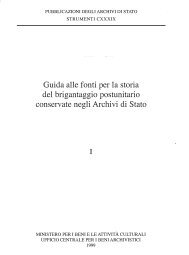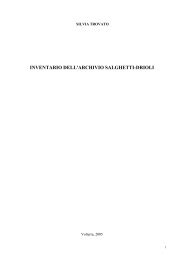ITALIA JUDAICA. Atti del I Convegno internazionale. Bari 18-22 ...
ITALIA JUDAICA. Atti del I Convegno internazionale. Bari 18-22 ...
ITALIA JUDAICA. Atti del I Convegno internazionale. Bari 18-22 ...
Create successful ePaper yourself
Turn your PDF publications into a flip-book with our unique Google optimized e-Paper software.
The third and concluding part, a gem of compression, asserts that in any<br />
event there is no human infalHbility. "Wisdom is greater than the wise man",<br />
he dec1ares, and -' he need not specify the obvious - our goal is wisdorn.<br />
The motto "perfection (perfect wisdom) is the sole prerogative of God" is<br />
reminiscent of Nahmanides' peroration to his Milpamo! ha-Shem, a defense of<br />
the great Alfasi against the strictures of Razah which in the final analysis<br />
also contains some fresh criticism cf Alfasi. Awareness of fallibility invites<br />
criticaI perspectives and independent efforts?7<br />
3. In assessing the cultural contributions of medieval Italian Jewry general!y,<br />
the historian concludes that ltaly, home of the oldest Jewish communities,<br />
marks a slow but sustained beginning. Italian Jewish authors, to be eclipsed<br />
in practically alI domains, are pioneers on the European scene: poetry -<br />
Amittai, Shefatiah, Solomon ha-Bavli and perhaps, fol!owing Ezra Fleischer's<br />
hypothesis, the first of ltalian payyelanim, Hedweta; science, philosophy and<br />
mysticism - Abu Aharon, Shabbetai Donnolo (and important, diversified<br />
contributions in the thirteenth century); history - Yosip.phon and A\Iima'az;<br />
rabbinics - R. Meshul!am b. Qalonymos, R. Natan of Rome, the anonymous<br />
Mishnah study and R. Isaac ben Malkizedeq. The historian may then turn<br />
to the test of endurance te determine how much of this did the national<br />
Jewish consciousness or universaI Jewish corpus of literature incorporate (e.g.<br />
liturgical pieces in the prayer book; the remarkable bibliographical odyssey<br />
of the 'Arukb, regular1y used and recurrently enlarged). When al! is said<br />
and done, there is no individuality, no Italian innovation, no indigenous<br />
development; there are contributions. This is especially salient in rabbinic<br />
literature.<br />
4. Isaiah Sonne was cognizant of this peculiarity and suggested that it be under<br />
stood in terms of challenge and response, i.e. that Italy, starting with the period<br />
of the disintegration of the Roman Empire, was too heterogeneous and diffuse<br />
to challenge Judaism and to elicit a new creative response. He says that<br />
Italy added 'notes and glosses' to the achievements of other centers without<br />
providing a distinctive achievement. It was and remained a receptacle to<br />
outside infIuences, impuIses and impetuses. Implicit in his historiographicaI<br />
27 This theme deserves study. There is a circular development: criticism is justified,<br />
and, subsequently, the precedent cf criticism (e.g.) Rabad versus Maimonides or R. Tam<br />
versus Rashi) validates the criticaI inclinations and practices cf later scho!ars. See, e.g., R.<br />
HAYYIM Y. BACHRACH, I:Iawwot Ya'ir,. n. 9; R. AEmAHAM AZULAI, Ba'ale Erit 'Abraham,<br />
introduction. Some reIy an the more pallid justification inherent in the Talmudic principie<br />
cf derosh we-qabel sakhar - see, e.g., DAVID PROVENCAL (in describing his pIan for<br />
study of Scripture and the best commentaries as part of his University curriculum), cited<br />
in S. ASSAF, Mekorot le-Toledot ha-Hinnukh, Tel-Aviv 1930, II, p. 1<strong>18</strong>. Rid does not rely<br />
on this prerogative at alI.<br />
398<br />
scheme is the notion that only a powerfuI, puIsating environment can be a<br />
stimulant or catalyst for Je\vish creativity and novel synthesis.28 Whatever<br />
one may say about the validity of this cultural-intellectual characterization in<br />
the fields of piyyut, philosophy, science, exegesis, 'and rnysticism, it seems<br />
technicaIly appropriate for rabbinic literature but without imposing his meta<br />
historical mold on the facts. The chal!enge and response theory is dispensable.<br />
Let the facts speak for themselves, unencumbered by debatable quasi-philos<br />
ophical rigidities. The title of this paper turns out to be rather precise.<br />
ltalian Jewry did not create a school, is not identified with a specific develop<br />
ment, did not cultivate any one genre with _exclusive passion, but ltalian sages<br />
did make contributions to rabbinic literature. It is for this reason that I tried<br />
to show how Rid is 'representative of trends, problems, and achievements, and<br />
no study of medievaI rabbinic Hterature may claim any measure of comprehens<br />
iveness without integrating his contributions, attitudes, and insights.<br />
A. T eshusot ha-Rid, n. 61.<br />
ApPENDIX<br />
':>1"7)71 :I,n 'n, pl':>n K':>tII '':>K nl1:111tII m ':>1: 'l1"7M':> :l'tII 'lN ':>:> l1':>nl1<br />
'lM n1 ,1'':>1: p':>m:> ;':ltlln:l nl1':>l: lÒl I1K) 111t111: ,., ;'':>'':>n ,':>") pn' 1l':I'<br />
'11)( !1N) 1M ,1':>n ',nM "1:1"7:1 ':> 'lK 1"7'':>11 "7ll:> 11l"111:> ,nN tIIll:"1El :ltllnl<br />
I:ll 'l'Nl ,n'':> Nll1" l"" )1l P I:tllln' n"1N 'N 'l'l::I nN"1l 1l'NtII "1:1"7 ':>:><br />
n"1:1"7Nl '':> nN"1"tII ,, 1'':>1: "1:1'':><br />
"1mM 'lNtII '':> nN"1ltll Clp:I 'lNtII n':>c lMl pntll:l " l:1 ,tlll:1N 1"'" C':>':> "71l 1'111"711:1<br />
'11:>n 'lN "11':> ':l':> 'ln'm'tII n':>'':>n ':>") C'l1t11N"1n "111:1"1 ''':I"7 'nN ':>:> ':>l: nEl'<br />
1':>NtII C'EllCl':>'!)n ':>n '11l:tII C'EllCl':>'!)n ':>tII 'l!l::I l' 'lN N':>N '':> n"711<br />
M':>'" 1l .,111' 1':>':>tllm 1:>n C'l1t11N.,"tII C'"71 1lnlN x':>;; l':> '''N' cn:lw ':>1"7l':><br />
1M'n 1111N I1Mm 1111p :-1:1.,n:l C;" "1:1"7 c,.,111Cl CrI'':>1: C''':J' 1lNW C" ' 1lMlN<br />
pll:n "1N '1r1 pll:;' lN Cl1n pm"' nElll! , cn" "N C:I'W .,111'<br />
'1':> 1l::>n CI1:>n1 n" l) "P'll) 1lNl CI1:>n 1l'N"W 'l!l1.1 c'pllln " Nll1 "l) C':I".,<br />
'"1:1"7 ':>1: .,:l'l N':>W "1:)1' 1lN:I 111 CNl ,cm C,,:>,,, llNW ,Òl C'''1N 1lNW nl:) ':>:><br />
"'11 nl1 .,C1N "11 m 'I: V",., mw C'Nl., 1lW Clpl.l:J P CM C'l1t11N"" ll'111:1.,<br />
m ':>'"7) mw .,I.l," C'l)Ntl:l l1,lI:I)1 c,.,n O';!)::> ';'pw':> ':>"ln 1'Ol , ':>1: llN<br />
28 L SONNE, Ha-Yahadut ha-'Italqit: Demutah U-Mekomah be-Toledot Am Yisra'e!,<br />
Jerusalem 1961. Sonne's characterization remains perceptive even if one is not persuaded<br />
by the theory.<br />
399



